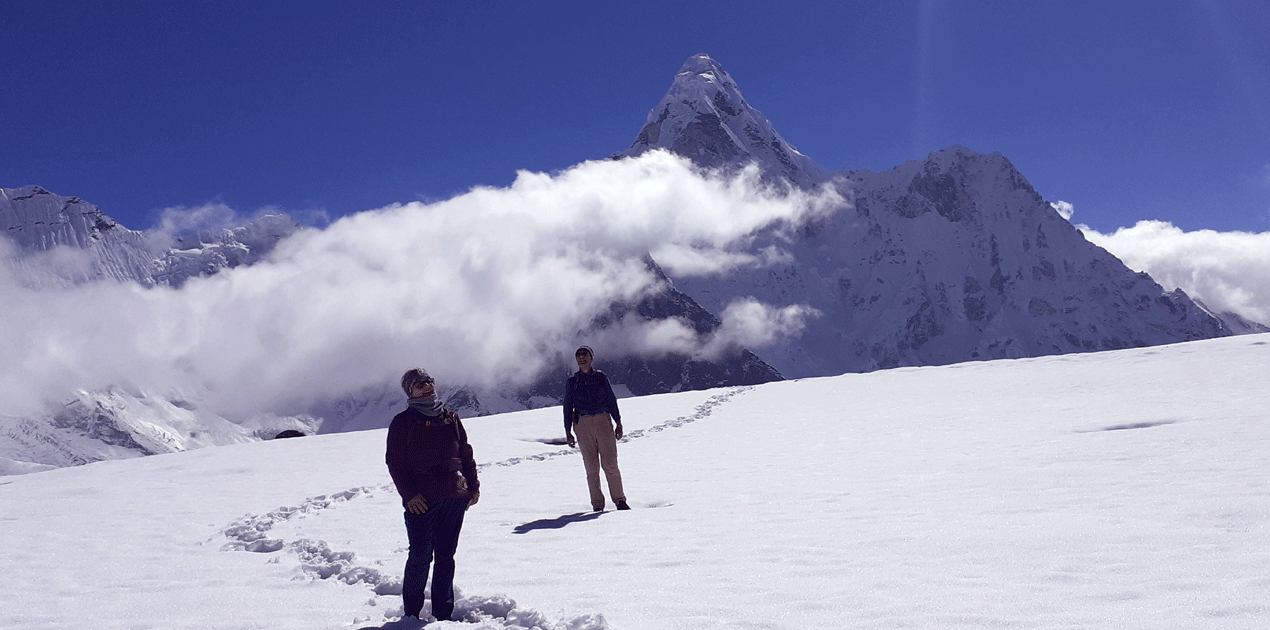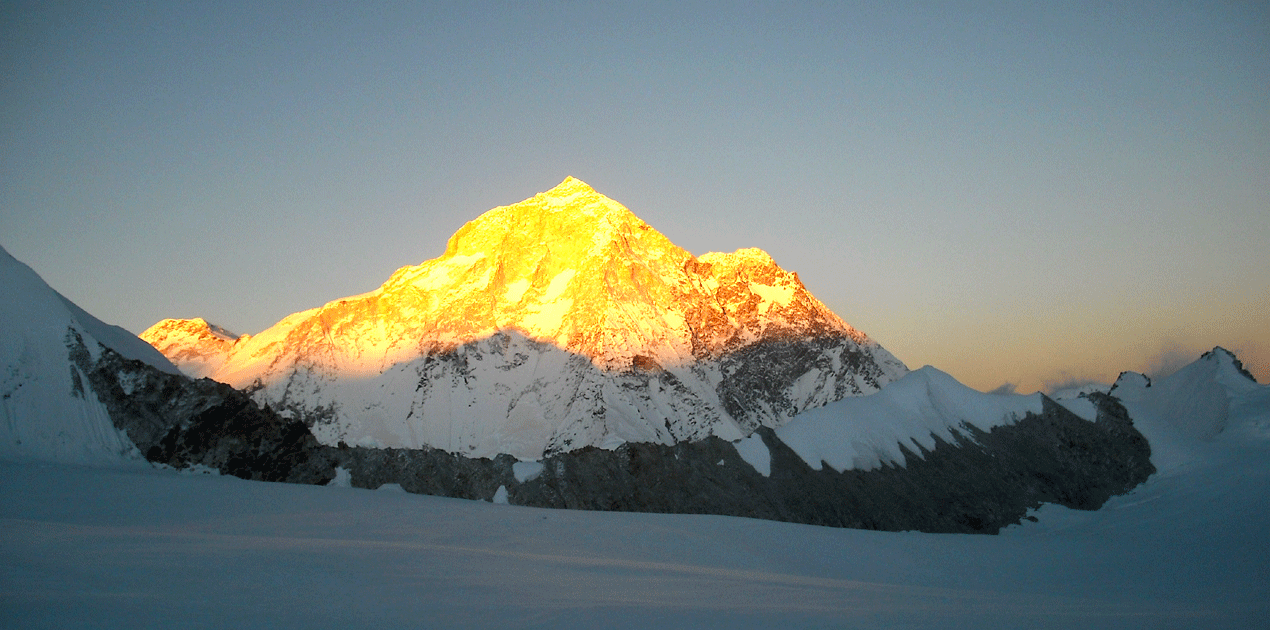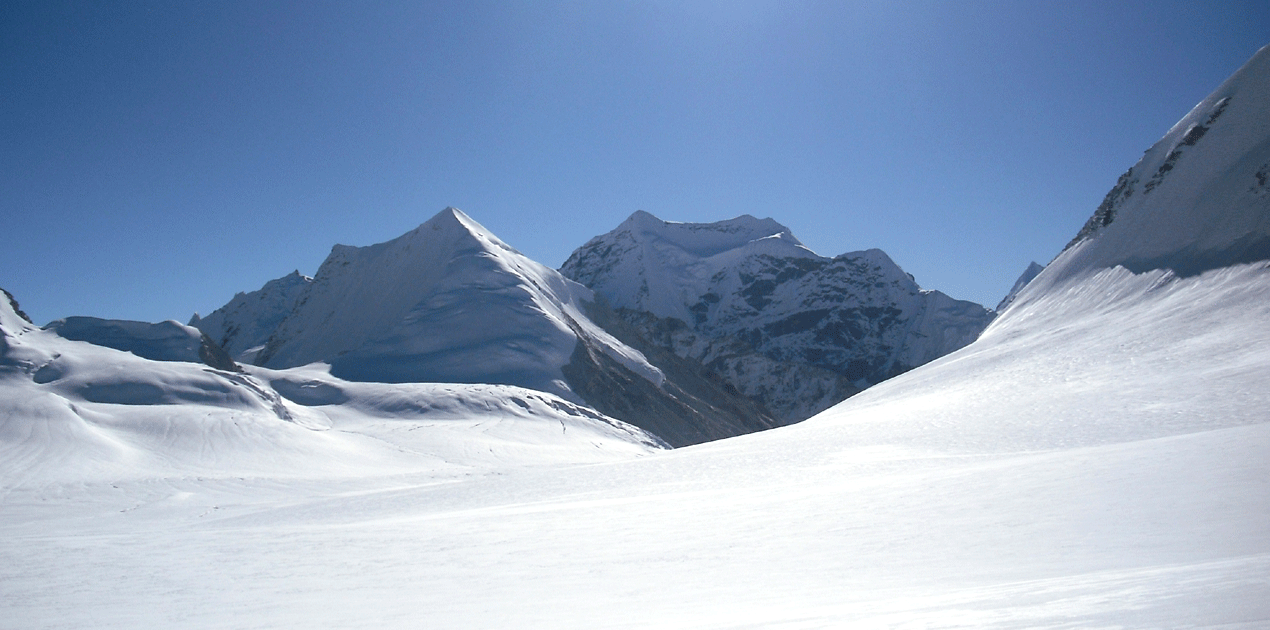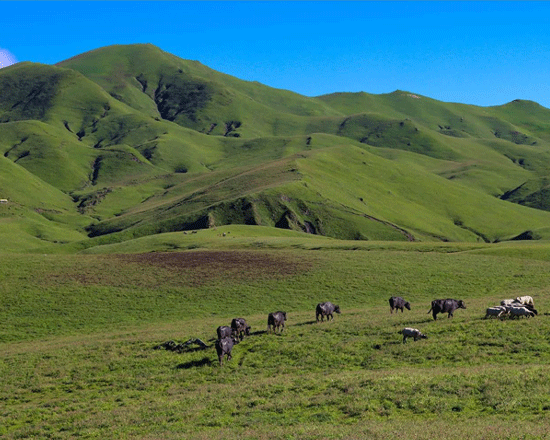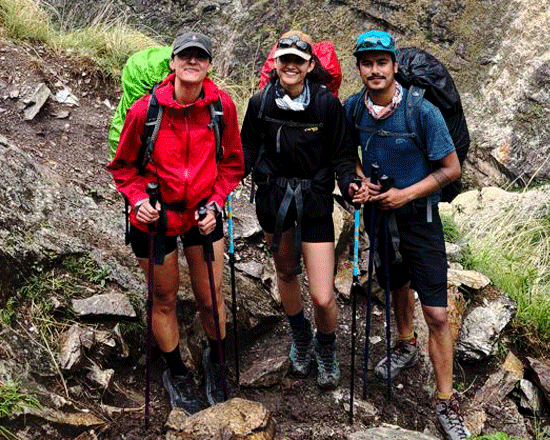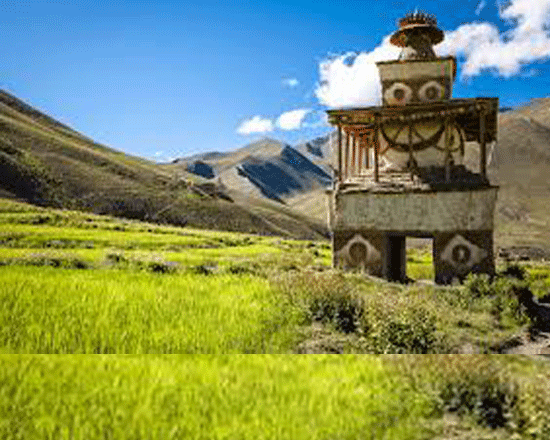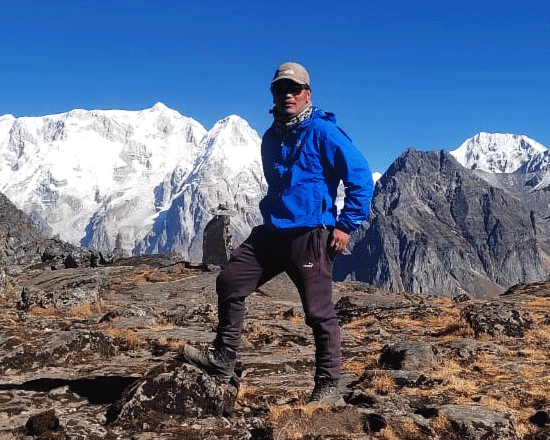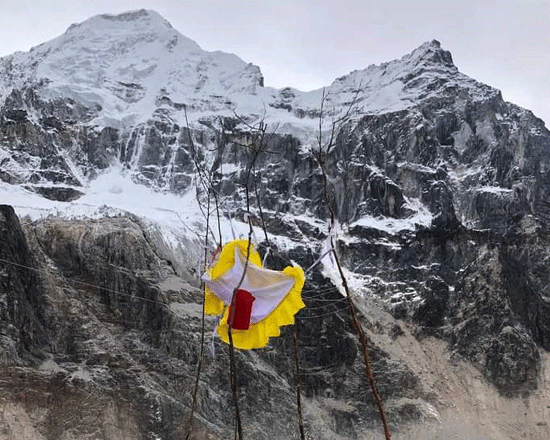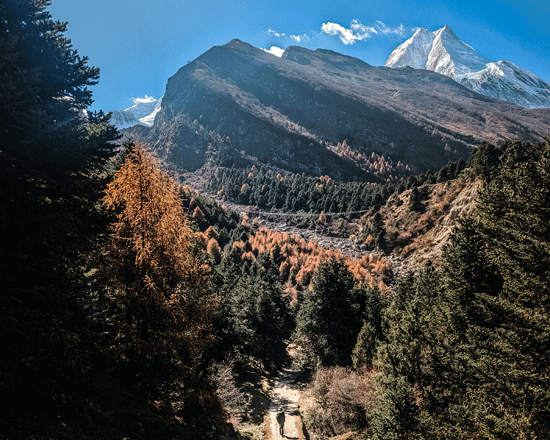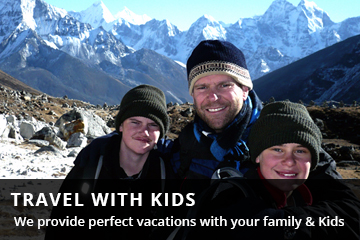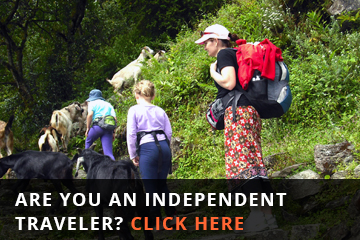Great Himalaya Trail
Great Himalaya Trail
Wilderness TrekkingTrip Facts
This is challenging and technical Trekking, climbing of Nepal, you most have to physically fit and mentally prepare, off the beaten trails, camping or challenging high passes Treks, at this level can he arranged for periods of 18 to 32 days. Typically, a gradual ascent through a green river valley will lead you up to a number of high passes, where you will reach the altitude of 5416m. Often times, you will get a close insight into the Tibetan culture. Participants should expect to trek above 5416m/17872ft. or climbing 6540m.
100%
Overview
The Great Himalaya Trail Trek:
Unraveling the Routes along the Great Himalaya Trail
The Great Himalayan Trail offers two distinct routes: the low Route and the upper Route. However, the upper route is considered the true Great Himalayan Trail. Drawing on our extensive 25-year experience in Nepal Trekking, we strongly recommend beginning your GHT journey from the eastern side. Nepal Wilderness Trekking has expertly crafted itineraries that allow you to complete the GHT route continuously or choose specific sections to conquer, accommodating your availability and preferences.
A Glimpse into the History of the Great Himalaya Trail
The legacy of the Great Himalaya Trail dates back to 1949, when Bill Tilman became the first chain traveler to explore the Helambu, Langtang, Kali Gandaki Valley, and Mount Everest regions. The introduction of organized trekking holidays in 1965 revolutionized travel, making the Himalayan regions accessible to adventurers from all walks of life. It’s worth noting that Nepal, though one of the most accessible countries, had strict ‘no-go’ areas along its border with Tibet until 2002. Since then, Nepal has opened all its mountains for permit-based trekking, attracting intrepid explorers eager to conquer the Great Himalayan Trail.
Nepal Wilderness Trekking stands as one of the pioneering trekking agencies championing the promotion of this iconic hiking route. Our seasoned trekking guides and travel planners possess unparalleled expertise in high-caliber trekking in Nepal. Following the guidance of our travel experts is highly recommended, given our comprehensive knowledge of the entire GHT course within Nepal.
The Great Himalayan Trail: A Brief Overview
The Great Himalayan Trail is a monumental undertaking, requiring approximately 150 days to complete. This epic journey meanders through the Nepal Himalayas, showcasing some of the world’s highest peaks. Your trek commences in the Kanchenjunga region, nestled in the shadows of Mt. Kanchenjunga, the third-highest mountain on the planet. This region, especially in spring, is renowned for its stunning Rhododendrons, adorning the hills with a kaleidoscope of colors.
Lumba Sumba Pass & Makalu Region
The trek to Kanchenjunga Base Camp includes crossing the Lumba Sumba Pass (5,178m) and venturing into the Makalu region. Basic tea houses provide respite in the Kanchenjunga region, inhabited predominantly by the ethnic Limbu and Rai communities. Camping is essential as you journey from Ghunsa westward to Lumba Sumba Pass.
Dividing the Great Himalayan Trail
For trekkers who wish to divide their Great Himalayan Trail adventure into sections, returning via Tumlingtar is recommended. Alternatively, continue northward toward the Nepal-Tibet border area, reveling in the beauty of the Makalu region (part of the Makalu Barun National Park) and captivating views of Mt. Makalu and Makalu Base Camp. The high route leads to Amphu Lapha, crossing the awe-inspiring Sherpani Col, offering breathtaking vistas of snow-clad peaks and towering mountains. Now, you’re in the heart of the Everest region, exploring the enchanting Khumbu valley. Accommodation is readily available in several tea houses along the route. After a trek that includes Gokyo lakes and a visit to Gokyo Ri, plus a crossing of Renjo-la pass, you transition into the Rolwaling valley via Tashi Lapcha pass, where Gurungs and Sherpas call this region home.
Rolwaling to Langtang: Tamang and Sherpa Cultures
Upon descending from the Rolwaling Valley through Tilman Pass, you’ll enter the Langtang Valley, home to the Tamang and Sherpa ethnic groups. This part of your journey exposes you to diverse customs, lifestyles, traditional attire, and unique languages specific to these ethnicities.
Continuing your odyssey, you’ll venture into the Ganesh Himal region and the Ruby Valley, where lush meadows and fertile pasturelands unfold against the backdrop of the mighty Annapurna range. In the Ruby Valley area, Gurung and Magar communities predominate.
Manaslu Region: Larke-la Pass and Annapurna Views
In the Manaslu area, your trek follows much of the Manaslu circuit’s route. The Larke-la pass (5,106m), north of Mt. Manaslu (8,163m), treats you to captivating views of the Annapurna mountain range, Mt. Manaslu, and the towering peaks of the east.
After conquering the Thorong-la pass at 5,416 meters, the Manaslu circuit trail merges with the Annapurna circuit trail, leading you to Manang and across the Thorong-la pass. As you descend, you’ll be rewarded with spectacular views of Upper Mustang, a region characterized by its barren yet incredibly colorful landscape. Along the way, a stop at Muktinath, a renowned pilgrimage destination, precedes your westward journey toward the Upper Dolpo trekking area. Upper Dolpo stands as one of Nepal’s remotest regions, boasting pristine natural beauty and a rich cultural heritage. During your trek, you might walk for days without encountering settlements, but you’ll likely cross paths with caravans of yaks and goats, either grazing or transporting goods.
Rara Lake to Simikot: Exploring Remote Villages
Continuing your journey off the beaten path, you’ll reach the serene oasis of Rara Lake, nestled at nearly 3,000 meters, framed by dense forests and distant snow-capped mountains. The route to Simikot takes you through remote areas that have seen few tourists. As you pass through local villages, you’ll gain insights into the lifestyles and traditions of the people residing in one of Nepal’s remotest and economically disadvantaged regions.
The route further leads to the remote Limi Valley trek, featuring abundant flora and fauna, ancient Buddhist monasteries, and rich religious traditions. From Simikot, the starting point of the Mt. Kailash trek, you can embark on the Great Himalayan Trail’s final leg, culminating at the Hilsa border crossing, the Nepal-Tibet border. The journey back to Kathmandu retraces your steps via Simikot.
Great Himalaya Trail distance
The Great Himalaya Trail (GHT) is not a single, fixed route; instead, it comprises a network of existing trails and routes that span the entire length of the Himalayas, covering roughly 1,600 miles (2,600 kilometers). This network offers trekkers a variety of experiences, from remote wilderness areas to culturally rich villages, showcasing the diverse landscapes and cultures of the region. The trail passes through six countries: Bhutan, Nepal, India, Pakistan, Tibet (China), and Afghanistan.
However, it’s important to note that the exact distance can vary depending on the specific route taken. Moreover, any deviations or side trips a trekker might choose to make along the way can also impact the overall length of the trek. Furthermore, the trail’s length is subject to change due to the establishment of new routes or modifications to existing ones.
Conclusion
A summary can hardly capture the grandeur of the Great Himalayan Trail high route. The trail unfolds an astonishing tapestry of landscapes, natural wonders, diverse lifestyles, cultures, and traditions unique to various ethnic groups. To delve deeper into these regions, explore the distinct sections of the Great Himalaya Trail. Our dedicated team at Nepal Wilderness Trekking is eager to guide you through the route options.
Detail Itinerary
- Day 1: Arrival in Kathmandu – Transfer from Tribhuvan International Airport to your hotel. Short briefing about the trek, equipment check, and welcome dinner.
- Day 2: Full-day sightseeing tour of UNESCO World Heritage Sites in Kathmandu Valley – including Swayambhunath (Monkey Temple), Pashupatinath Temple, Boudhanath Stupa, and Kathmandu Durbar Square.
- Day 3: Fly from Kathmandu to Bhadrapur (eastern Nepal) and drive to Taplejung – a scenic journey through the tea estates and hills of Ilam.
- Day 4: Drive to Lelep and begin trek to Sekathum (1,650m) – following the Tamor River valley.
- Day 5: Trek to Amjilosa (2,500m) – a steep climb through lush forest and waterfalls.
- Day 6: Trek to Gyabla (2,725m) – crossing suspension bridges and remote hamlets.
- Day 7: Trek to Ghunsa (3,475m) – a traditional Tibetan village.
- Day 8: Acclimatization day in Ghunsa – short hikes to surrounding ridges, explore monasteries.
- Day 9: Trek to Khambachen (4,050m) – spectacular views of Jannu Himal (Kumbhakarna).
- Day 10: Trek to Lhonak (4,780m) – open landscapes with Himalayan glaciers.
- Day 11: Trek to Pangpema (5,140m) – Kanchenjunga North Base Camp.
- Day 12: Trek down to Khambachen – retracing steps.
- Day 13: Trek to Pale village – farming and yak-herding community.
- Day 14: Trek to Nango-La Base Camp – base of the challenging Nango La Pass.
- Day 15: Cross Nango La (4,776m) and trek to Yagma Khola.
- Day 16: Trek to Olangchung Gola (3,200m) – an ancient trading village with a centuries-old monastery.
- Day 17: Rest day in Olangchung Gola – visit historic sites and Tibetan-style homes.
- Day 18: Trek to Upper Lanmale – remote trail through pine and rhododendron forest.
- Day 19: Trek to Pass Camp – camping below high passes.
- Day 20: Cross Lumbasumba Pass (5,178m) and trek to Yak Kharka.
- Day 21: Trek to Thudam – Tibetan settlement.
- Day 22: Trek to Kharka – pastureland used by herders.
- Day 23: Trek to Chyamtang – Sherpa village with Buddhist influence.
- Day 24: Trek to Honkon – remote high-altitude camp.
- Day 25: Trek to Bakim Kharka.
- Day 26: Trek to Molun Pokhari – alpine lake.
- Day 27: Trek to Kharka.
- Day 28: Trek to Cave Camp – rugged and wild terrain.
- Day 29: Trek to Kalo Pokhari (Black Lake).
- Day 30: Trek to Yak Kharka.
- Day 31: Trek to Yangla Kharka.
- Day 32: Trek to Langmale Kharka.
- Day 33: Trek to Makalu Base Camp (4,870m) – stunning view of Mt. Makalu (8,463m).
- Day 34: Acclimatization and exploration at Makalu Base Camp.
- Day 35: Trek to Swiss Base Camp.
- Day 36: Extra day – learning basic climbing safety & rope handling.
- Day 37: Trek to Sherpani Col Base Camp.
- Day 38: Cross Sherpani West Pass (6,143m) to Baruntse Base Camp.
- Day 39: Trek to Hunku Valley.
- Day 40: Trek to Amphu Laptsa Base Camp.
- Day 41: Cross Amphu Laptsa Pass (5,800m) and descend to Chhukung (4,730m) – entrance to Everest region.
- Day 42: Rest and recovery day in Chhukung.
- Day 43: Trek via Khumbala Pass (5,335m) to Lobuche (4,910m).
- Day 44: Trek to Gorakshep (5,164m).
- Day 45: Hike to Kala Patthar (5,556m) for Everest views, then trek to Dzongla.
- Day 46: Cross Cho-La Pass (5,420m) to Gokyo (4,790m).
- Day 47: Rest and exploration day at Gokyo. Optional hike to Gokyo Ri (5,400m).
- Day 48: Cross Renjo-La Pass (5,345m) and descend to Lumde.
- Day 49: Trek to Thame – traditional Sherpa village.
- Day 50: Trek to Parchemuche Tsho.
- Day 51: Trek to Tashi Lapcha Base Camp.
- Day 52: Cross Tashi Lapcha Pass (5,760m) and camp at Glacier Camp.
- Day 53: Trek to Na Village (Rolwaling Valley).
- Day 54: Trek to Beding.
- Day 55: Trek to Simigoun.
- Day 56: Trek to Orang Danda.
- Day 57: Trek to Loting.
- Day 58: Trek to Bigu Gompa – historic Buddhist monastery.
- Day 59: Rest day – interact with nuns at the Female Buddhist School.
- Day 60: Cross Tinsang Pass (3,780m) to Sano Jyandan.
- Day 61: Trek to Last Resort.
- Day 62: Trek to Listi.
- Day 63: Trek to Shotang Kharka.
- Day 64: Trek to Chogomogor Kharka.
- Day 65: Trek to Kyansin.
- Day 66: Trek to Tembathan.
- Day 69: Trek to Chedupa Kharka.
- Day 70: Rest day.
- Day 71: Trek to Nemagchupka Kharka.
- Day 72: Trek to Panch Pokhari (Five Lakes).
- Day 73: Trek to Intermediate Camp.
- Day 74: Trek to Tin Pokhari.
- Day 75: Trek to Tilman South Base Camp.
- Day 76: Cross Tilman Pass (5,320m) to Tilman North Base Camp.
- Day 77: Trek to Kyanjin Gompa (Langtang Valley).
- Day 78: Trek to Lama Hotel.
- Day 79: Trek to Syabrubesi.
- Day 80: Rest and shopping day.
- Day 81: Trek to Gatlang.
- Day 82: Trek to Somdang via Khurpu Danda (3,710m).
- Day 83: Cross Pansan Pass (3,830m) to Tipling.
- Day 84: Trek to Lapa Khola.
- Day 85: Cross Mangro Bhanjyang (2,940m) to Nauban Kharka.
- Day 86: Trek to Keranja.
- Day 87: Trek to Jagat.
- Day 88: Trek to Deng.
- Day 89: Trek to Namrung.
- Day 90: Trek to Sama.
- Day 91: Day hike to Pungen Gompa, return to Sama.
- Day 92: Trek to Samdo.
- Day 93: Trek to Dharamsala (Larke Phedi).
- Day 94: Cross Larke La Pass (5,161m) and descend to Bhimtang.
- Day 95: Trek to Dharapani.
- Day 96: Trek to Chame.
- Day 97: Trek to Upper Pisang.
- Day 98: Trek to Manang.
- Day 99: Trek to Ledar.
- Day 100: Trek to High Camp.
- Day 101: Cross Thorong La Pass (5,416m) to Muktinath.
- Day 102: Rest day in Muktinath.
- Day 103–154: (continues as per your original outline with details of Dolpo, Rara, and Humla section including high passes, monasteries, alpine lakes, and cultural villages until completion at Simikot and return to Kathmandu).
Cost Included
- Pick-up and drop-off at the airport are included in the package.
- Accommodation in a 3-star hotel in Kathmandu with a bed & breakfast (BB) plan.
- All domestic flights as per the itinerary.
- All ground transportation as per the itinerary.
- Insurance and equipment for the Nepali trekking crew.
- Licensed government trekking guide and porter (1 porter for every 2 trekkers during camping).
- Guided city sightseeing tour with entrance fees and private transportation.
- Medical kit (first-aid box) included.
- All government and local taxes.
- Group climbing equipment (personal climbing gear not included).
- Accommodation during the trek in teahouses or homestays, where available.
- All meals during the trek – breakfast, lunch, and dinner.
- National park entry permits and government paperwork.
- Complimentary duffel bag provided by the company.
- Satellite phone set for safety and communication.
- Farewell dinner at the end of the trek.
Cost Excluded
- Nepal entry visa fees (to be obtained upon arrival at Kathmandu airport).
- International flights to and from Nepal.
- Personal expenses such as battery charging, snacks (chocolates, candies, etc.), Wi-Fi, and hot showers.
- Personal travel insurance, including coverage for emergency rescue and evacuation.
- Meals in the city (lunch and dinner) and any extra accommodation due to early arrival, late departure, or unforeseen circumstances.
- All beverages, including alcoholic drinks, soft drinks, bottled water, coffee, and tea.
- Bank wire transfer charges or any additional financial transaction fees.
- Tips for the guide, porter, driver, and trekking crew (at your discretion, but customary in Nepal).

